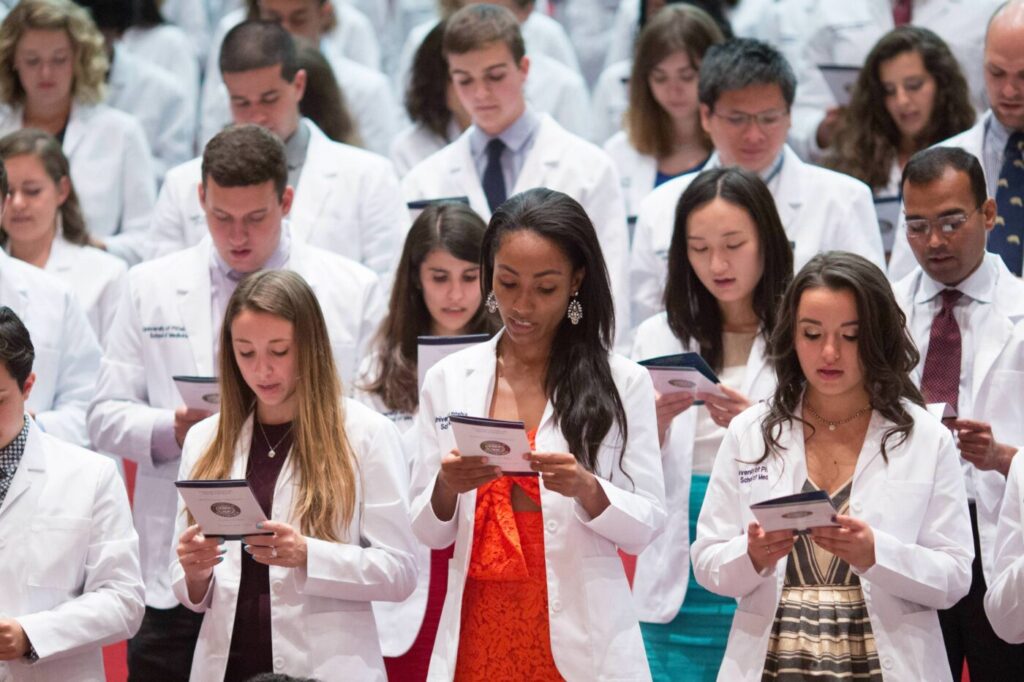The University of Pittsburgh School of Medicine (UPSOM) is one of the finest institutions in the nation, consistently ranking a top medical school for research and primary care. Pitt is a research powerhouse that continues to climb ‘best public university’ lists, and has been among the top 10 recipients of National Institutes of Health (NIH) funding every year since 1997. Expanding facilities, a beautiful campus, and engaging, contemporary curriculum — there are plenty of reasons UPSOM attracts the attention of so many prospective medical students.
This articles organizes important information about UPSOM into an extensive, ultimate guide for medical school applicants. If you believe the University of Pittsburgh School of Medicine is the right fit for you, and you’re excited to apply, you are in the right place. Consider bookmarking this page to use as a resource during the application process.
Be an Informed Applicant
The University of Pittsburgh is often considered one of America’s Public Ivies, and its School of Medicine consistently places well in national medical school rankings. Given its stature and appeal, as well as its low acceptance rate, prospective students should familiarize themselves with the school’s achievements, programs, culture, and selection factors. By doing so before applying and interviewing, you’ll be equipped with the knowledge needed to impress the admissions committee and increase your chances of a successful application. After all, variations of the ‘Why this school?’ question will come up again and again during the application and interview process. Informed, fluent answers are the best way communicate that you are confident and intentional in your decision to apply to UPSOM.
This article will go into:
• UPSOM’s History, Accomplishments, and Core Values
• Medical Programs Offered at UPSOM
• UPSOM’s Selection Factors
• University of Pittsburgh Medical School Requirements
• Acceptance Rate, School Rankings, and Other Helpful Statistics
• UPSOM Cost of Attendance
• AMCAS Primary Application and UPSOM Secondary Application
• UPSOM Secondary Application Essay Questions, Example Answers, and Advice
• UPSOM Interview Questions and How to Prepare for Your Interview
• Admissions Consulting and Healthcare Internships
The information on this page is intended to provide a comprehensive and useful explanation of UPSOM and its application process. Still, getting into medical school can be quite challenging. Consider our medical school admissions consulting if you want hands-on assistance navigating the application process, fine-tuning your essays and CV, or even if you’re just unsure about a few things. We’re here to help!
History, Accomplishments, and Core Values
To begin, let’s spend some time on the history and values of Pitt’s School of Medicine to better understand how the institution sees itself, and what role it hopes to play in the future of medicine.
Brief History of the University of Pittsburgh School of Medicine
The school dates back to 1886, when it was chartered by local physicians. Within 25 years it became part of the University of Pittsburgh and was one of the most cutting-edge medical schools in the region. In 1910, UPSOM was cited by The Flexner Report as the gold standard for University management. Early on, UPSOM was looked up to by medical schools across the country as an exemplary pedagogical institution.
In 1986, Barbara I Paull published “A century of medical excellence: The history of the University of Pittsburgh School of Medicine,” which documents the research, practices, and educational advancements of 100 years of UPSOM.
Famous Accomplishments
Innovations at the University of Pittsburgh have contributed to a wide range of technical achievements, including the first ‘heavier-than-air’ aircraft, TV technology that enabled filming on the moon, and the first radio broadcast across the Atlantic Ocean. Here’s a list of notable medical contributions that Pitt and the School of Medicine have given the world.
• The first polio vaccine was developed by Jonas Salk and his colleagues at the University of Pittsburgh.
• Doctor Fisher’s research on breast cancer has led to longer, improved lives for many of those diagnosed with the disease.
• The virus that causes epidemic cancer in HIV/AIDS patients was isolated by Pitt’s Yuan Chang and Patrick Moore.
• More than 17,000 organ transplants have been done by Pitt surgeons, making the city the world’s transplantation capital.
• The protein receptor for insulin was isolated by Dr. Klaus Hofmann at the University of Pittsburgh, who also discovered how peptides bind to proteins.
• CPR was developed by a Peter Safar, a professor of medicine at Pitt.
• UPSOM established the first critical care medicine department in an American medical school.
• Pitt professors William Klunk and Chester Mathis pioneered research to help the early diagnosis of Alzheimer’s, for which they received the Potamkin Prize.
• Professor P.G. Katsoyannis was the first to synthesize insulin, along with his colleagues at the University of Pittsburgh.
Core Values
According to Anantha Shekhar, MD, PhD, the Dean of the School of Medicine, Pitt Med values first and foremost leadership, creativity, and compassion. The school’s primary mission is to foster and use top-tier biomedical research and science to improve the health of populations across the globe. Academic integrity, professionalism, and high ethical standards are core pillars of UPSOM’s institutional identity.
While Pitt Med’s research credentials are highly prized by the school, patient care is an equally important part of the school’s core values. Students begin working with patients early, and, as with any excellent medical school, compassion and empathy are key elements of the educational process.
Pitt’s School of Medicine strives to maintain a diverse student body, and emphasizes recruiting students from underrepresented communities. The Health Sciences Diversity, Equity and Inclusion Department works with students and admissions to amplify the number of professionally trained scientists and physicians from underrepresented backgrounds and communities.
Medical Programs at University of Pittsburgh School of Medicine
Pitt Med has a variety of medical programs on offer. Here are the main ones prospective students should know about.
• Doctor of Medicine (MD)
• Doctor of Medicine/Doctor of Philosophy (MD/PhD program)/Medical Scientist Training Program (MSTP)
• Dual Degree Programs
• Residency and Fellowship Programs
• Summer Research Programs
• Clinical Scientist Training Program (CSTP)
• Physician Scientist Training Program (PSTP)
MD Program
The curriculum at Pitt Med integrates lecture and problem-solving approaches with deep clinical experience, starting in year one.
The school uses a longitudinal approach to fully cover it’s Curricular Themes, over the entirety of the four-year MD program. UPSOM’s Curricular Themes address a variety of medical topics, such as social medicine, Spanish language skills, public health, women’s health, and Opioid epidemic and addiction.
Additionally, MD students engage in a Longitudinal Research Project to hone their skills in research and creative problem solving, and to better understand the experience of participating in long-term research. The Longitudinal Research Project is conducted over the course of 3 years and provides a wide range of research opportunities.
Curriculum – The main curriculum blocks at UPSOM are Foundations of Medicine (FOM) Block, Organ Systems Pathophysiology Block (OSP), Evidence and Discovery Block (E&D), Patient, Physician and Society Block (PPS), and Introduction to Patient Care Block (IPC).
1st Year Foundations of Medicine Block:
• Medical Anatomy
• Human Genetics
• Fuel Metabolism
• Immunology
• Tissues in Health and Disease
• Pharmacology
• Medical Microbiology
1st Year Introduction to Patient Care Block:
• Introduction to Medical Interviewing
• Intro to Physical Exam
• Advanced Physical Exam
• Clinical Experiences
• HIPAA Training for Medical Students
1st Year Patient Physician and Society Block:
• Intro to Being a Physician
• Ethics, Law, and Professionalism
• Behavioral Medicine
1st Year Evidence and Discovery Block:
• Evidence-Based Medicine — Fundamentals
• Evidence-Based Medicine — Applied
1st Year Organ Systems Pathophysiology Block:
• Neuroscience
• Introduction to Psychiatry
2nd Year Patient Physician & Society Block:
• Population Health
• Racism in Medicine
2nd Year Organ Systems Pathophysiology Block:
• Body Fluid Homeostasis: Cardiovascular
• Body Fluid Homeostasis: Renal
• Body Fluid Homeostasis: Pulmonary
• Digestion & Nutrition
• Skin & Musculoskeletal Diseases
• Hematology
• Endocrine
• Reproductive & Developmental Biology
• Integrated Case Studies
2nd Year Evidence and Discovery Block:
• Investigation & Discovery
• Longitudinal Research Project
2nd Year Introduction to Patient Care Block:
• HIPAA Training for Medical Students
• Advanced Physical Examination
• Clinical Experiences
• Advanced Medical Interviewing
• Clinical Procedures
3rd Year Clerkships:
• Adult Inpatient Medicine
• Adult Outpatient Medicine
• Anesthesiology
• Neurology
• Family Medicine
• Obstetrics & Gynecology
• Pediatric
• Psychiatry
• Specialty Care
• Surgery
3rd Year Clinical Focus Courses:
• Preclerkship Course
• Interprofessional Geriatrics Week
• Assessment Week
4th Year:
• Continue Clerkship Rotations
• 8 electives
• An acting internship (Family Medicine, Internal Medicine, Pediatrics, or Surgery)
• An integrated life science course (Changing Science, Changing Society: A Guide to 21st Century Medicine; Clinical Pharmacology; Infectious Disease in Obstetrics, Gynecology and Reproductive Medicine; Neoplasia and Neoplastic Disease; Neurosurgery and Head and Neck Dissection; Science of Resuscitation)
• A residency boot camp course (Anesthesiology, Emergency Medicine, Internal Medicine, Obstetrics & Gynecology, Pediatrics, Psychiatry, or Surgery)
• 2 recess/interview periods
MD Areas of Concentration
The University of Pittsburgh school of Medicine offers the following Areas of Concentration for students interested in pursuing concentrated studies in particular medical fields. The Areas of Concentration teachings utilize academic literature, faculty mentorship, research, student authored scholarly project (such as a lecture or presentation), and student evaluations. The program spans all 4 years of the MD program, and students may apply to participate upon acceptance to UPSOM.
• Addiction Medicine
• Bioengineering, Biotechnology, and Innovation
• Disabilities Medicine
• Geriatric Medicine
• Global Health and Underserved Populations
• Health Systems Science
• Infectious Diseases
• Medical Humanities and Ethics
• Neuroscience
• Public Health
• Reconstructive and Regenerative Medicine
• Resuscitation
• Women’s Health
Professional Enrichment Courses
UPSOM’s Professional Enrichment Courses provide medical students the opportunity to pursue studies in areas outside the normal UPSOM curriculum. These courses are intended to expose students to specialties of personal interest to them. Professional Enrichment Courses are offered to 1st and 2nd-year students in good academic standing, and course usually has 4-8 sessions.
Professional Enrichment Courses include:
• Practical Medical Conversations in Spanish
• Being Physician
• Clinical Radiology and Anatomy: Learning Anatomy Through Imaging
• Point-of-Care Ultrasound (POCUS) Basics
• Refugee Health
• A Seizure or Not a Seizure: How to Evaluate and Seize the Seizure
• Approaching Pediatric Disease through the Microscope
• Artificial Intelligence and Machine Learning
• Bystander Emergency Response
• Calling the Shots – A Guide to Vaccines
• Cardiac Surgery 101
• Difficult Conversations in the COVID-19 Era
• Drawing for Seeing and Understanding: The Human Figure
• Environmental Health
• Exploring Bias Through Reflective Practice
• Family Planning – Beyond the Basics
• Health Policy
• How Did We Get Here? Practical Lessons on the History of Medicine
• How to Win at Research: A Guide to Presenting and Publishing More
• How We Breathe: Applied Pulmonary Physiology
• Intimate Partner Violence: Introductory IPV Education for Medical Students
• Introduction to Anatomic Pathology
• Introduction to Dermatology
• Intro to Global Health and Surgery
• Introduction to Ophthalmology
• Intro to Otolaryngology Head and Neck Surgery
• Introduction to Regional Anesthesia: Learning Ultrasound Guided Nerve Blocks
• Interprofessional Care
• Introduction to Vascular Surgery
• Mini Biopsy
• Money Smart
• Multi-Disciplinary Approach to the Diagnosis of Musculoskeletal Neoplasms
• Narrative Medicine
• Neuroanatomy Applied – Stroke by Stroke
• Orthopaedic Surgery Sports Medicine
• Palliative Care Communication Skills
• Personalized Medicine: The Impact of Molecular Testing on Patient Care
• Plastic Surgery
• Podcasting in Medical Education – A Why and How Guide
• Point-of-Care Ultrasound (POCUS) Basics
• Practical Medical Conversations in Spanish
• Principles of LGBTQ+ Health
• Rehabilitation Concepts in Muscle, Joint, Brain and Nerve Physiology
• Transitions: Primary Care’s Role in Addiction Medicine
• Wellness and Resilience for Medical School and Beyond
In addition to the above courses, Pitt Med also offers long term enrichment courses. The Longitudinal Professional Enrichment Courses include:
• American Geriatrics Society Organ Block Case Series
• Essential Procedures in Clinical Medicine
• Mind Body Seminar Series for MS1
• Mind Body Seminar Series for MS2
• The Emergency Expert
• Wellness and Resilience for Medical School and Beyond
OMED Certificate Programs for MD Students
The Point-of-Care Ultrasound Certificate Program (POCUS-CP) is for students interested in gaining expertise in bedside ultrasound use. Additionally, UPSOM awards students with over 100 hours of community service the OMED Community Service Certificate.
MD/PhD Medical Scientist Training Program (MSTP)
The Medical Scientist Training Program (MSTP) is Pitt Med’s MD/PhD path, which bridges undergraduate medical programs with 22 graduate programs provided by the University of Pittsburgh and Carnegie Mellon University. MSTP is designed for students with a strong, defined interest in biomedical research. This program takes 7-8 years to complete.
Dual Degree Programs
The University of Pittsburgh offers many dual programs that integrate Pitt’s School of Medicine. Here are the programs that are formally coordinated through UPSOM:
• Joint Degree in Medicine and Bioethics (MD/MA) – This path allows School of Medicine MD students to earn a Master of Arts degree (with a concentration in bioethics) from the Dietrich School of Arts and Sciences. Students may apply during their MD studies or before matriculation.
• Multidisciplinary Master of Public Health Program (MMPH) – The University of Pittsburgh School of Public Health coordinates with the School of Medicine to offer numerous multidisciplinary degree paths.
Fellowships and Residencies
UPSOM graduates who pursue their academic career with the University of Pittsburgh Schools of Health Science will have a wide range of residencies and fellowships to apply to, including:
• Anesthesiology
• Pediatric/Anesthesiology
• Dermatology
• Emergency Medicine
• Family Medicine
• Internal Medicine
• Internal Medicine/Pediatrics
• Neurology
• Neurological Surgery
• Obstetrics & Gynecology
• Ophthalmology
• Orthopaedic Surgery
• Otolaryngology
• Pediatrics
• Physical Medicine and Rehabilitation
• Plastic Surgery
• Psychiatry
• Child & Adolescent Psychiatry
• Radiation Oncology
• Radiology
Summer Research Programs
UPSOM offers the following research program opportunities for MD students during the summer months. These intensive programs are 9 weeks long, and combine biomedical research with general research career guidance.
• Cell Biology and Physiology
• Cellular and Molecular Pathology
• Molecular Genetics and Developmental Biology
• Molecular Pharmacology
• Microbiology and Immunology
• Molecular Biophysics and Structural Biology
Clinical Scientist Training Program (CSTP)
The CSTP trains future clinical investigators in the practices of clinical research. This program includes a MD/MS path, as well as a MD/Certificate path.
The CSTP is usually taken between the 3rd and 4th year of medical school and involves a year of research studies. The program includes formal coursework, mentored clinical research, and provides financial support for those accepted into the program.
Physician Scientist Training Program (PSTP)
The PSTP integrated research curriculum and laboratory work throughout the School of Medicine’s 4 year MD program. The program begins with laboratory rotations in the summer before attending medical school. Monthly “Works in Progress Seminars” provide PSTP students a forum to discuss their research with their peers and mentors.
Supported areas of research for PSTP students include:
• Bioengineering
• Biomedical Informatics
• Cancer
• Cardiology
• Chemistry
• Computational Biology
• Critical Care Medicine
• Developmental Biology
• Dermatology
• Endocrinology and Metabolism
• Emergency Medicine
• Epidemiology
• Female Health
• Human Genetics
• Immunology
• Infectious Diseases
• Microbiology and Molecular Genetics
• Neurobiology
• Neurology
• Neuropathology
• Neuroscience
• Neurosurgery
• Ophthalmology
• Orthopedic Surgery
• Pathology
• Pediatrics
• Pharmacology
• Plastic Surgery
• Psychiatry
• Renal
• Structural Biology
• Surgery
• Transplant
• Vascular Medicine
• Vascular Surgery
UPSOM’s Selection Factors, Academic Requirements, and Other Prerequisites
Selection Factors
When applying to medical school, your academic record, MCAT scores, and application essays are all important parts of any medical school application. However, many institutions consider certain selection factors more important when assessing candidates. Pitt Med prefers applicants with the following qualities.
• Ability to communicate and interact – Given the amount of collaborative learning environments facilitated in the Pitt Med curriculum, ideal applicants demonstrate a desire to interact with others, as well as strong communication skills.
• Letters from former mentors/faculty – Pitt Med gives special consideration to recommendation letters that give a compelling account of your collaboration skills. If you’ve worked with faculty members on academic or extracurricular projects, prioritize recommendation letters from them.
• Resourcefulness – Leadership, resourcefulness, and creative problem solving are important pillars of UPSOM’s institutional identity. Pitt Med pays special attention to applicants who demonstrate the resourcefulness required to embark on personal projects.
In additional to this criteria, cultural competency, adaptability, integrity, and more are listed in UPSOM’s selection factors.
University of Pittsburgh Medical School Requirements
Here is a full list of Pittsburgh medical school requirements.
• Recommended areas of study: The Pitt Med Admissions Committee prefers applicants with a strong background in mathematics. They also favor students with a wide range of course work, such as liberal arts students, and those who have studied the social sciences and humanities. As long as the required science course work is met, applicants with non-science majors are regarded positively. The Curriculum Committee also recommends at least on half year of psychology.
• Required coursework:
Biology – 1 full year (including 1 year lab or single 2 credit lab)
General/Inorganic Chemistry – 1 full year (including 1 year lab or single 2 credit lab)
Organic Chemistry – 1 half year (including 1 half year lab or single credit lab)
Biochemistry – 1 half year
Physics – 1 full year (including 1 year lab or single two credit lab)
English/Intensive Writing – 1 full year (may include writing intensive classes such as Philosophy)
Statistics – 1 half year (preferably Biostatistics, excludes Calculus)
Course work that embodies equivalent education may be accepted on a case by case basis.
• GPA and MCAT Scores: UPSOM does not have a required grade point average or MCAT score minimum. Applicants must take the MCAT to apply, and results older than 3 years will not be accepted. If you take the MCAT multiple times, the Admissions Committee will consider the highest score.
While there are no hard-line requirements here, excellence is expected. The median GPA for students admitted in 2021 was 3.83. The median MCAT score was 516, and ranged from 492 to 525.
Class Profile and School Rankings
Here are some useful statistics to help you better understand the institution’s standing and expectations.
University of Pittsburgh School of Medicine Class Profile (Acceptance Rate, Demographics, and More)
Pitt Med currently has a 2.09% acceptance rate, though this has been as high as 6.02% in recent years. There were 8,601 applicants in 2021.
92% of those admitted to Pitt Med in 2021 had research experience. 87% had clinical shadowing experience, and 86% had medical/clinical community service experience.
64% of new students majored in Science or Math. 25% were under-represented minorities. 58% were female.
41% were in-state residents.
Pittsburgh University School of Medicine Rankings
Pitt Med ranks #13 for Best Medical Schools: Research, and #34 for Best Medical Schools: Primary Care, according to the 2022 U.S. News & World Report.
UPSOM also ranks:
• #6 in Psychiatry
• #11 in Surgery
• #11 in Obstetrics and Gynecology
• #56 in Most Diverse Medical Schools
• #99 in Most Graduates Practicing in Medically Underserved Areas
Additionally, the University of Pittsburgh ranks #20 in Top Public Schools.
AMCAS Primary Application and UPSOM Secondary Application
To apply to medical school, you must complete two applications: a primary and a secondary application. for most institutions, your primary application will be AMCAS. After you submit your AMCAS application, it will be sent to Pitt Med and any other schools you apply to.
Pitt Med will provide you with a link to complete their secondary application after you’ve completed the primary AMCAS application.
For a more in-depth explanation, take a look at our article on understanding the differences between primary and secondary medical school applications.

UPSOM Secondary Application Essay Questions, Sample Answers, and Advice
The essays you submit on UPSOM’s supplementary application are critical opportunities to communicate your skills and goals in a compelling and engaging manner. Aside from the Pittsburgh medical school requirements, these answers can make or break your application. The Pitt Med Admissions Committee will carefully examine your answers, so take the time and care needed to put your best foot forward.
Here are the essay topics from University of Pittsburgh School of Medicine’s secondary application for the 2021-2022 academic year. We’ve included some example answers and suggestions for how to approach and structure your responses.
For in-depth tutelage on how to optimize your medical school essay responses, consider IMA’s medical school admissions consulting.
Essay Prompt #1
Tell us about a challenging problem you faced and how you resolved it. (Limit your response to 250 words or less.)
Without preparation, answers to this question can quickly spiral out of control. It’s important to keep your answers confined to a professional or academic setting — the more relevant to challenges you’ll face at Pitt Med and as a doctor, the better. (If you’ve done any voluntary healthcare internships abroad, or have any healthcare related experience, use a story from this.) Explain the setting, the challenge, how you resolved it, and, most importantly, what you learned from the experience.
Here’s an example answer to this prompt. The applicant employs a clear narrative structure and uses their time wisely by highlighting volunteer experience, clinical interests, and personal history. This answer also fits UPSOM’s preference for candidates with collaborative spirits and interpersonal skills.
During my sophomore year of college, I volunteered with Women Leaders, an all-girls mentorship group dedicated to promoting confidence and academic success in middle school students. I began to notice that one student had consistently poor attendance. When I talked to her mentor, I learned that the student’s family had recently taken in her grandmother, who suffered from Alzheimer’s.
When I was younger, my family took me on weekly visits to see my grandmother, who had been bed-ridden with cancer since I could remember. I didn’t tell this to the student’s mentor, as she had given me a hard time in the past and I was intimidated by her. I felt powerless and frustrated that the mentor wasn’t doing anything to help the student.
I contacted the mentor before the next meeting and told her about my grandmother. The mentor thanked me, and told me it helped her understand the student’s situation. We contacted the student’s parents, who encouraged her to attend the next meeting.
At the meeting, we veered from our usual agenda and encouraged students and mentors to discuss challenges they were facing. To my surprise, the truant student talked openly about her situation. After that, she continued to attend and participate in the meetings.
This experience taught me the power of empathy. It also taught me that looking past personal scruples can lead to productive relationships. Finally, it gave me the courage to pursue a career in end-of-life care.
Essay Prompt #2
UPSOM is committed to building a diverse and talented community that will train physicians in delivering culturally competent, person-centered care, and promoting a supportive, collaborative learning environment. To achieve this, we want our fellow students to recognize health disparities and advocate for health equity. We are interested in combating all forms of systemic barriers, and would like to hear your thoughts on opposing specifically: systemic racism, anti-LGBTQ+ discrimination, and misogyny. How will you contribute? (Limit your response to 250 words or less.)
Most applications will have a version of what is called the “cultural competency” question. This is because the medical community understands that underserved populations receive better care when physicians, researchers, and healthcare advocates are diverse and knowledgeable about different perspectives, needs, and challenges.
This question is quite specific, however. It asks: What will you do to oppose systemic racism, anti-LGBTQ+ discrimination, and misogyny? For candidates without sufficient social science and humanities backgrounds, this can be challenging to answer in a compelling way. Let’s walk through some necessary knowledge about this problem and suggestions for how to answer.
• Systemic oppression, in this case racism, anti-LGBTQ+ discrimination, and misogyny, is the cumulative result of historical, economical, legal, cultural, and sociological discriminatory practices. While individuals are responsible for authoring and perpetuating certain practices, systemic oppression is ultimately a structural phenomenon. This means that systemic oppression happens intentionally and unintentionally, as is the case with discriminatory practices that are seen as “normal” or “just the way things are.” Because of this, the process of unlearning oppressive behavior, listening to marginalized communities, and critically examining institutional norms are essential to recognizing systemic barriers. A competent answer will demonstrate an understanding of what systemic barriers are, as well as the challenge of recognizing them when they don’t affect you.
• Answers to this question could demonstrate openness to critical dialogue for students from privileged backgrounds, or an understanding of intersectionality for those from marginalized communities. Intersectionality is the cumulative effect of multiple forms of discrimination and their unique challenges. (For instance, a gay able-bodied black woman experiences misogyny differently than a heterosexual disabled white woman.)
• Include examples of relevant advocacy, speaking out against discrimination, or your personal challenges with systemic discrimination.
• Include descriptive examples of systemic barriers in the United States healthcare system, such as access to LGBTQ+ friendly healthcare providers or underfunded clinics in communities of color. What role can your specific career play in solving these issues?
Essay Prompt #3
Please write about anything else you would like to add to your application, or anything you would like to emphasize to the Admissions Committee. (Limit your response to 250 words or less.)
“Anything else?” questions are a wonderful opportunity to discuss other relevant information or go into detail about something you didn’t have the space to elaborate on before. This prompt is very open-ended, but take care to avoid repeating information from your AMCAS or previous responses.
When responding to this prompt, considering the following:
• Is there anything more to your qualifications or ambitions that you didn’t have room to address in previous essays?
• What are your other responses missing that prevents you from communicating why you are an appealing candidate?
• Is there anything you previously wrote about that could use additional, relevant details?
Interview Questions and How To Prepare
Every interview is unique and depends on the institution, the applicant, and the interviewer. Still, there are a few things you should anticipate.
Here are some details about UPSOM’s interview process, as reported by former applicants.
• Number of interviewers: 1
• Length of interview: 45-60+ minutes
• Stress level of the interview: medium to low
• Type of interview: one-on-one and usually closed file
• Interviewees reported few surprise questions and generally found the interview to go as expected
Interview Questions
Here are top reported questions asked in previous Pitt Med interviews.
“Why Pitt Med?”
“What makes you unique?”
“Why a career in medicine?”
“How does your major connect to medicine?”
“What specialty do you want to go into and why?”
“Tell me about your research.”
“Tell me about a time you had to work collaboratively.”
“Have you ever interacted with someone from a culture/group different from your own?”
“Tell me about your volunteer experience.”
“How do you handle stress?”
“How would you talk to a patient that was skeptical of science or the healthcare system (i.e. COVID-19 and mask policies)?”
“What challenges do you think are facing healthcare and medicine today?”
“How have your experiences prepared you for medicine?”
“What are some qualities a physician should have?”
“What is your definition of success?”
How to Prepare for Your Interview
In addition to academic excellence, Pitt Med describes the ideal candidate as having great interpersonal and communication skills. The admissions committee looks for creativity, intellect, and compassion. In addition to these qualities, you will also be evaluated based on your knowledge of healthcare in general and your informed enthusiasm for the specialty you’re pursuing.
It’s normal to feel nervous about this kind of interview — there’s a lot to cover and plenty of things to keep in mind! Don’t worry, we’re here to help. Among other things, this article equips you with a thorough understanding of the school you’re applying to, which is a nice advantage. The admissions committee wants to hear that you are applying to Pitt Med to contribute to and utilize the school’s strengths. By studying the school, you will be able to communicate your ambitions in a way that demonstrates how Pitt Med is uniquely situated to help you succeed.
Here are some things to keep in mind while you’re being interviewed, as well as some preparation strategies.
• Consider medical school admissions consulting. Even those who feel comfortable in interview settings will benefit from mock interviews and structured feedback from medical education experts.
• Throughout the day, practice answering the following interview questions listed above. Note the strong answers you come up with, as well as any questions you tend to fumble with.
• Prepare a small list of good questions for the interviewer.
• Express your enthusiasm for the institution. Go into your knowledge of specific UPSOM programs and accomplishments and why they excite you.
• Answer questions completely and include relevant information, but remain direct. Most of your responses should be 2-4 minutes long.
• Conduct mock-interviews with friends, family, or colleagues.
• Keep things simple and organized the day of the interview. Visit the campus beforehand, have your route planned, and give yourself plenty of travel time.
• Keep in touch with your support network leading up to the interview.
• If you have healthcare experience, such as IMA’s voluntary healthcare internships abroad, work on a compelling, succinct story that encapsulates what you learned.
• Finally, be yourself.
Remember to reflect on what makes you unique and fit for medical school. Take advantage of open-ended questions (such as “tell me about yourself”) by sharing stories that demonstrate your personality and strengths. Think beyond the Pittsburgh medical school requirements and focus on your personal skill set.
Admissions Consulting and Healthcare Internships
For students with adequate academic performance and promising MCAT scores, two things still stand in your way when it comes to medical school applications: communicating your strengths and providing compelling healthcare experience. Even the perfect candidate misses opportunities to put their best foot forward when applying or preparing to apply to medical school. It’s a tough process to navigate, especially alone.
We’re here to help. For over 25 years, International Medical Aid has assisted thousands of students attend the top medical schools across the country. Our medical school admissions consulting leverages decades of medical and educational expertise to provide effective guidance and support. We offer 30-minute complementary consultations to help decide your best path forward.
Additionally, our immersive global healthcare internships provide you with once-in-a-lifetime healthcare training that serves underserved communities around the world. These voluntary healthcare internships abroad are formative pre-med experiences that leave you with lasting knowledge, compelling stories that demonstrate your moral fiber, and an exceptional skill set.
We hope you’ve found this information useful on your path to becoming a future physician or researcher. Remember to check out our other ultimate medical school guides.
- University of Wisconsin Medical School
- VCU School of Medicine
- University of Maryland School of Medicine
- Case Western Medical School
- University of North Carolina Medical School
- University of Florida Medical School
- Emory University School of Medicine
- Boston University College of Medicine
- California University of Science and Medicine
- UC San Diego Medical School
- California Northstate University College of Medicine
- Touro University of California
- CHSU College of Osteopathic Medicine
- UC Davis School of Medicine
- Harvard Medical School
- UC Riverside School of Medicine
- USC Keck School of Medicine
- UT Southwestern Medical School
- Long School of Medicine at UT Health San Antonio
- University of the Incarnate Word School of Osteopathic Medicine
- UT Austin’s Dell Medical School
- UTMB School of Medicine
- McGovern Medical School at UT Health
- Johns Hopkins School of Medicine
- McGovern Medical School at UT Health
- The University of Texas Rio Grande Valley School of Medicine
- UNT Texas College of Osteopathic Medicine
- University of Houston College of Medicine
- Texas A&M College of Medicine
- Johns Hopkins Medical School
- Baylor College of Medicine
- George Washington University School of Medicine
- Vanderbilt University School of Medicine
- St. George’s University School of Medicine
- Lake Erie College of Osteopathic Medicine (in Pennsylvania)
- Sidney Kimmel Medical College at Thomas Jefferson University
- Wake Forest University School of Medicine
- Western University of Health Sciences (in California)
- Drexel University College of Medicine
- Stritch School of Medicine at Loyola University Chicago
- Georgetown University School of Medicine
- Yale School of Medicine
- Perelman School of Medicine
- UCLA Medical School
- NYU Medical School
- Washington University School of Medicine
- Brown Medical School
We wish you the best of luck in your academic and professional career!









